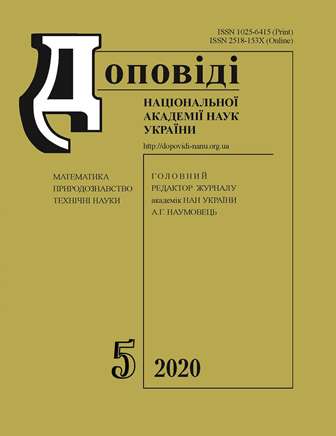Black minismokers — a possible factor of generation of black shale formations of the euxinic type
DOI:
https://doi.org/10.15407/dopovidi2020.05.052Keywords:
black shales, black smokers, euxenits, hydrogen sulfide degassing, tube problemsAbstract
Fragments of pyritizited tubes of cylindrical or conical shapes have been detected as a result of examining the rocks of a black shale formation (Lower Visean, central part of the Dnieper-Donets depression, the cores of oil and gas deep wells) on an electron microscope. These tubes are filled by colomorphic, spongic and framboidal forms of microbiogenic pyrite. It constitutes the considerable portions of enclosing black shales. These tubes and associated forms of pyrite are supposedely the segments of a microchimney system of deep H2S-degassing. It seems likely that the holes in the walls of these tubes are connected with the cavitation of gas bubbles. Their appearance is related to the spraying of a two-phase fluid flow. Cavitation microexplosions perforated the tube walls. These brittle ephemeric structures are possible analogs of the black smokers. Their discovery allows us to reveal the geological conditions of the formation of black shales of the euxinic type. This should promote, in turn, the development of these formations as a nontraditional source of hydrocarbons and various metals.
Downloads
References
Jenkins, H. C. (1973). Cretaceous anoxic events from continents to oceans. J. Geol. Soc. London, 137, No. 2, pp. 171-188. Doi: https://doi.org/10.1144/gsjgs.137.2.0171
Lukin, A. E. (1999). Paleontology in the system of natural sciences. Sanct-Petersburg, pp. 48-49 (in Russian).
Lukin, A. E. (2013). Geology and minerals of the World ocean, No. 4, pp. 5-28 (in Russian).
Yudovich, Ya. E. & Ketris, M. P. (1988). Geochemistry of black shales. Leningrad: Nauka. (in Russian).
Lukin, A. E. (1997). Lithogeodynamic factors of oil and gas accumulation in aulacogenic basins. Kiev: Naukova Dumka (in Russian).
Shnyukov, E. F., Starostenko, V. I. & Gozhik, P. F. (2001). On the high gas output from Black Sea bottom. Geol. J., No. 4, pp. 7-14 (in Russian).
Maslennikov, V. V., Ayupova, N. R., Maslennikova, S. P., Tseluyko, A. S. (2016). Hydrothermal biomorphozes of pyrites fields: microtextures, microelements and criteria of detection. Ekaterinburg: RIO Ur.ORos.AN (in Russian).
Jones, M. L. (1981). Riftia pachiptila Jones Observations on the Vestimentiferan worms from Galapagos Rift. Science, 213. Doi: https://doi.org/10.1126/science.213.4505.333
Nesis, K. N. (1984). Vestimentiferans. Priroda, No. 4, pp. 87-89 (in Russian).
Lobier, L. (1990). Oases on the ocean floor. Leningrad: Gidrometizdat (in Russian).
Gebrook, A. V. (Ed.). (2002). Biology of hydrothermal systems. Moscow: KMK Press (in Russian).
Machulina, S. A. (2008). Geological conditions for the formation of a “black smoker” in the Donbas. Dopov. Nac. acad. nauk Ukr., No. 12, pp 107-110 (in Russian).
Lukin, A. E. (2003). Geodynamics and petroliferous structures of the Black sea — Azov sea region. IV Int. Conf. “Crimea-2002”. Simferopol (in Russian).
Fornari, D. J., Embley, R. W. (1995). Tectonic and volcanic controls on hydrothermal processes at the midocean ridge: An overview based on near-bottom and submersible studies. Seafloor Hydrothermal Systems: Physical, Chemical, Biological and Geological Interactions. Ed. S.E. Humphris el al. Geophysical Monograph Series, 91, pp. 1-46. Doi: https://doi.org/10.1029/GM091p0001
Volynsky, M. S. (1986). Unusual life of usual drop. Moscow: Znanie (in Russian).
Downloads
Published
How to Cite
Issue
Section
License
Copyright (c) 2023 Reports of the National Academy of Sciences of Ukraine

This work is licensed under a Creative Commons Attribution-NonCommercial 4.0 International License.




